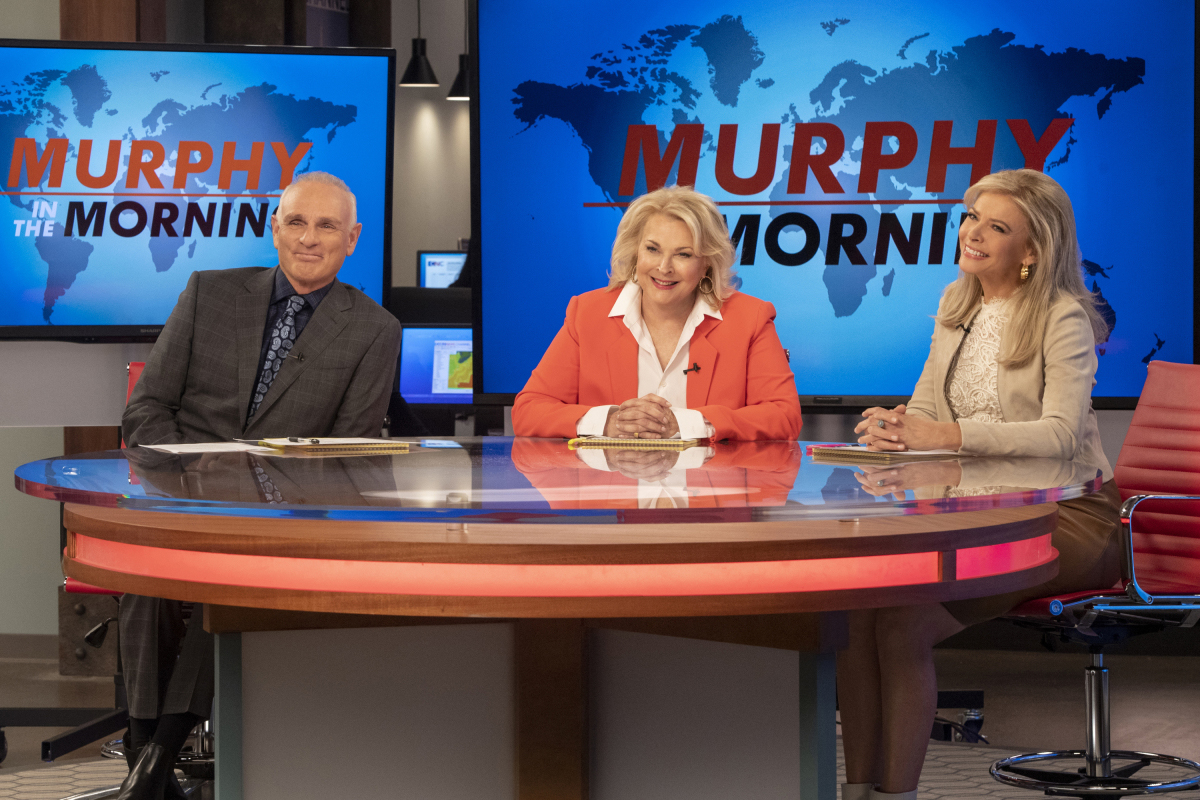
Groan, if you must, at the pink “Original Nasty Woman” sweatshirt Murphy Brown is wearing in her first prime-time appearance since the Clinton administration, but you can’t deny that she deserves the title. Candice Bergen’s righteous, irascible TV journalist was making powerful men—namely, Vice President Dan Quayle—nervous even before Bill and Hillary moved into the White House. It already felt safe to assume that Murphy would have backed Mrs. Clinton in 2016, and that she would scream with all the anguish of a Munch painting when her candidate lost to Donald Trump.
That CBS’s revived Murphy Brown, which premieres on Sept. 27, opens with this election-night wail, preceded by a montage of Clinton and Trump clips from the campaign trail, speaks volumes about its intended audience. It seems impossible that anyone watching this particular show could possibly need a reminder of what it was like to live through those months. But before she flashes forward to the 2018 Women’s March (in lieu of a pussy hat, Murphy wears a Roman centurion’s helmet topped with hot-pink feathers), creator Diane English, who wrote the episode, seems determined to activate liberal viewers’ anger. Asked about how she expects Trump voters to receive the show, English has said, “They’re not going to watch us” and “I don’t think we’re looking to bring them into the tent.” In 2018, Murphy Brown is primal scream therapy for the Resistance.
Admittedly, English’s heroine—a feminist icon with a sixth sense for spotting corruption, lying and egotism—makes a pretty ideal mouthpiece for Trump-era outrage. Murphy Brown’s return to TV and Murphy Brown’s return to the anchor’s desk seem equally inevitable, and the setup for both comebacks is no more elaborate than it needs to be: Bored after her retirement from the broadcast newsmagazine FYI and itching to blurt truth to power, Murphy conceives a cable morning show over beers at Phil’s (now run by Phil’s sister Phyllis, played by the great Tyne Daly) with her old colleagues. While slick investigative reporter Frank Fontana (Joe Regalbuto) is languishing in academia, perky Corky Sherwood (Faith Ford) has just been replaced on a Today-like program by a younger, sexier weather girl. (FYI’s resident old-school newsman, Charles Kimbrough’s Jim Dial, has taken refuge from the 24/7 news cycle on the high seas but comes ashore for brief arc beginning in Episode 3.) Even their fragile, anxiety-ridden former producer, Miles Silverberg (Grant Shaud), reluctantly signs on.
The new show, Murphy in the Morning, comes complete with a walking millennial stereotype: Pat Patel (Atypical’s Nik Dodani, making the best of a broad character), a sweet yet officious social media whiz. It’s hard to tell whether Pat was added in hopes of attracting an audience too young to have watched Murphy the first time around or as comedy relief for a core viewership that might enjoy a laugh at the expense of “kids today,” but he isn’t the only 20-something upstart here. Murphy’s son Avery (Jake McDorman of Greek and Limitless) has grown up to be a TV journalist, and he’s developing a rival morning show as the “token liberal” on the conservative Wolf Network. This is a coincidence that only a network sitcom with a laugh track would float, and even if you can suspend your disbelief, Avery is so underwritten that his Pod Save America T-shirt says more about him than his storylines. Like the late Robert Pastorelli’s hip house painter Eldin Bernecky, from the original series, he exists mostly to give Murphy someone to talk to at home. But Eldin was a fully formed character whose slacker machismo made him a perfect foil for her. Couldn’t Avery at least have been a Bernie Bro?
Murphy is stronger when it sticks to the workplace, both because the veteran cast members are still so sharp and because Murphy in the Morning forces the show to trade generic political outrage for more specific stories about the many challenges facing a news media that the president has tarred as “the enemy of the American people.” (The show itself openly baits the White House, too, with faux Trump tweets about Murphy and broadsides against Sarah Huckabee Sanders that make Michelle Wolf’s burns sound like compliments.) While jokes about Trump being “Facebook friends with Putin” feel borrowed from two-year-old protest signs, an episode centered around a rather thinly veiled Steve Bannon character is an especially potent mix of topical humor and object lesson in media literacy. Characters argue over whether Murphy should annihilate the provocateur in an on-air interview or simply refuse to “normalize” his nativist beliefs by giving him a platform on national TV.
But Murphy Brown’s greatest asset has always been Murphy Brown, a unique creation for whom English and Bergen both deserve credit. Watching the show as a kid in the ’90s, when female sitcom characters generally came in two varieties—hot chick and long-suffering mom—Murphy was, to me, something entirely new, a woman defined not by her appearance or her family, but by her smart, principled fury. Bergen recaptures that force-of-nature energy in every frame of the revival; even in a TV landscape rich with complex women, there’s no one else quite like Murphy. As well suited as she is to her new role as Resistance warrior, it’s her ferocious vitality that gives Murphy Brown its eternal appeal.
More Must-Reads from TIME
- Cybersecurity Experts Are Sounding the Alarm on DOGE
- Meet the 2025 Women of the Year
- The Harsh Truth About Disability Inclusion
- Why Do More Young Adults Have Cancer?
- Colman Domingo Leads With Radical Love
- How to Get Better at Doing Things Alone
- Michelle Zauner Stares Down the Darkness
Contact us at letters@time.com